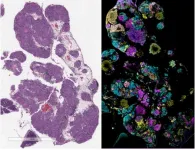(Press-News.org) The brain constantly engages in dialogue with the body’s immune system. Such communication appears aimed at ensuring a delicate balance between defending against injury and infection and guarding healthy tissue.
Now, scientists at Washington University School of Medicine in St. Louis have revealed how the two strike a healthy balance. The study, in mice, found that fragments of immune-stimulating proteins – dubbed guardian peptides – are produced by the brain and spinal cord of the central nervous system to maintain the brain’s immune balance and permit a healthy interchange of information with the immune system.
The study, published Oct. 30 in the journal Nature, has the potential to improve treatments for diseases, such as multiple sclerosis (MS) and Alzheimer’s disease, among others.
“We have found guardian brain peptides that actively engage with the immune system to keep it in check, possibly preventing destructive immune responses,” said Jonathan Kipnis, PhD, the Alan A. and Edith L. Wolff Distinguished Professor of Pathology & Immunology and a BJC Investigator at WashU Medicine. “We think such peptides help the immune system to maintain a state of ‘immune privilege.’ We are intrigued by the possibility of developing such proteins from healthy brains into a therapy to suppress inappropriate immune responses and develop better disease-modifying therapies for neuroinflammatory diseases.”
Immune surveillance involves a subset of T cells that can initiate an immune response when alerted to a threat. That alert comes in the form of a tiny protein fragment – a sample of the potential threat – displayed on the surface of another group of presenting immune cells. If T cells deem the protein fragment threatening, they mount an attack.
The researchers found that guardian peptides were presented by immune cells at the interface of the brain’s borders, where they attracted and activated a subset of immune T cells whose function is regulatory, such that these cells dampen abnormal immune reactions.
Min Woo Kim, a graduate student in WashU Medicine’s Medical Scientist Training Program and a researcher in the Kipnis lab, examined presenting immune cells from the brain and its associated immune tissues in healthy mice. He found an abundance of brain proteins presented by such cells, with the dominant protein being a component of myelin sheath, the protective cover on neurons that becomes damaged in MS.
The researchers found that in mice with MS, such proteins were drastically depleted. By adding the missing brain-derived peptides through injection of vesicles – membrane-bound compartments – into the cerebrospinal fluid of mice with MS, the scientists found that the therapy activated and expanded a subset of suppressor T cells. Motor function improved, and disease progression slowed in the treated mice compared with mice that received control vesicles.
“We have identified a novel process in the brain where the organ actively engages with the immune system to present a healthy image of itself,” Kim said. “That image looks different in mice with multiple sclerosis. We think that other neuroinflammatory and even neurodegenerative diseases may have unique protein signatures presented to the immune system, opening the exciting possibility of using such signatures as a diagnostic tool for early diagnosis.”
WashU Medicine collaborators on the study include Cheryl Lichti, PhD, an associate professor of pathology & immunology; Clair Crewe, PhD, an assistant professor of cell biology & physiology; Maxim N. Artyomov, PhD, the Alumni Endowed Professor of Pathology & Immunology; and the late Emil R. Unanue, PhD, who died before seeing the study’s completion. Unanue, a 1995 Albert Lasker Basic Medical Research Award winner, was a pioneer in describing the interactions between T cells and presenting cells that make it possible for the former to recognize and respond to foreign invaders.
END
Healthy brains suppress inappropriate immune responses
Harnessing this process may offer therapies for neuroinflammatory diseases, mouse study suggests
2024-10-30
ELSE PRESS RELEASES FROM THIS DATE:
Large meltwater accumulation revealed inside Greenland Ice Sheet
2024-10-30
A new study published in Nature unveils a surprising discovery: a substantial amount of meltwater is temporarily stored within the Greenland Ice Sheet during summer months. For the first time, an international group of researchers was able to quantify meltwater with positioning data. The finding challenges current models of how ice sheets contribute to global sea level rise.
The Greenland Ice Sheet is currently the largest single contributor to global sea-level rise, with the potential to raise the mean sea level by up to seven meters if it fully melts. While ...
Ancient DNA brings to life history of the iconic aurochs, whose tale is intertwined with climate change and human culture
2024-10-30
Geneticists from Trinity College Dublin, together with an international team of researchers, have deciphered the prehistory of aurochs – the animals that were the focus of some of the most iconic early human art – by analysing 38 genomes harvested from bones dating across 50 millennia and stretching from Siberia to Britain.
The aurochs roamed in Europe, Asia and Africa for hundreds of thousands of years. Adorned as paintings on many a cave wall, their domestication to create cattle gave us a harnessed source of muscle, meat and milk. Such ...
Reversing environmental decline: Lessons from African communities
2024-10-30
In rural Africa, where livelihoods are often tied directly to the land, environmental degradation poses a critical threat to both ecosystems and people’s well-being. New research reveals ways to tackle the dual challenges of land degradation and poverty.
In rural Africa, where livelihoods are often tied directly to the land, environmental degradation poses a critical threat to both ecosystems and people’s well-being. A new study co-authored by researchers at Stanford University and the French Agricultural Research Centre for International Development (CIRAD) analyzes how ...
'Black box' of stem cell transplants opened in world-first blood study
2024-10-30
For the first time, scientists have tracked what happens to stem cells decades after a transplant, lifting the lid on the procedure that has been a medical mystery for over 50 years.
Insights could pave the way for new strategies in donor selection and transplant success, potentially leading to safer, more effective transplants.
Researchers from the Wellcome Sanger Institute and their collaborators at the University of Zurich were able to map the behaviour of stem cells in recipients’ bodies up to three decades post-transplant, ...
New pathway for sensing cold temperatures identified in rice
2024-10-30
A gene called COLD6 contributes to cold tolerance in rice, potentially offering a pathway to use molecular design to breed a rice variety with higher resistance to cold stress. This work appears October 30 in the Cell Press journal Molecular Cell.
“Cold damage is a major challenge in rice production, and identifying key gene modules in signalling pathways is a crucial step in addressing this issue,” says senior study author Kang Chong of the Chinese Academy of Sciences. “Our research focused on uncovering the molecular mechanism behind crops’ response to cold stress. We hope to ...
Study identifies how ovarian cancer protects itself, paves way for improved immunotherapy approach
2024-10-30
New York, NY [October 30, 2024]—Researchers at the Icahn School of Medicine at Mount Sinai have discovered a way that ovarian cancer tumors manipulate their environment to resist immunotherapy and identified a drug target that could overcome that resistance.
The study, published in the October 30 online issue of Cell [DOI: 10.1016/j.cell.2024.10.006], used a cutting-edge spatial genomics technology and preclinical animal models, with tumor specimens from ovarian cancer patients further validating the findings.
The researchers found that ovarian cancer cells produce a molecule called Interleukin-4 (IL-4), which is typically ...
State policies regulating law enforcement access to prescription drug monitoring program testosterone prescription data
2024-10-30
About The Study: This study found that testosterone prescription data through prescription drug monitoring programs was accessible to law enforcement without basic safeguards (such as a warrant or subpoena) in nearly half of states. The ease of access to this sensitive medical information raises privacy, care quality, and civil liberties concerns, especially amid the proliferation of gender-affirming care bans.
Corresponding Author: To contact the corresponding author, Katie McCreedy, MPH, email mccreedy.k@northeastern.edu.
To access the embargoed study: Visit our For The Media website at this link https://media.jamanetwork.com/
(doi:10.1001/jama.2024.20035)
Editor’s ...
Validation of the Kansas City Cardiomyopathy Questionnaire in patients with tricuspid regurgitation
2024-10-30
About The Study: In this cohort study, the Kansas City Cardiomyopathy Questionnaire (KCCQ) had strong psychometric properties in patients with severe tricuspid regurgitation, including reliability, responsiveness, and validity. These data support use of the KCCQ in patients with severe tricuspid regurgitation as a measure of their symptoms, function, and quality of life and also for assessing the impact of interventions, such as transcatheter tricuspid valve intervention, in rigorously controlled trials.
Corresponding Author: To contact the corresponding ...
New study shows combination therapy slows cognitive decline in at-risk populations
2024-10-30
An important new study led by the Centre for Addiction and Mental Health (CAMH), and with partnership across several Toronto Dementia Research Alliance (TDRA) sites— Baycrest, Sunnybrook Health Science Centre, Unity Health Toronto, and University Health Network— has demonstrated that a combination therapy can slow cognitive decline in older adults at risk for dementia.
The study was published today in JAMA Psychiatry: "Slowing cognitive decline in major depressive disorder and mild cognitive ...
Slowing cognitive decline in major depressive disorder and mild cognitive impairment
2024-10-30
About The Study: This study showed that cognitive remediation and transcranial direct current stimulation, both targeting the prefrontal cortex, is efficacious in slowing cognitive decline in older adults at risk of cognitive decline, particularly those with remitted major depressive disorder (with or without mild cognitive impairment) and in those at low genetic risk for Alzheimer disease.
Corresponding Author: To contact the corresponding authors, email Benoit H. Mulsant, MD, MS, (benoit.mulsant@utoronto.ca) and Tarek K. Rajji, MD, (tarek.rajji@utsouthwestern.edu)
To access the embargoed study: Visit our For The Media website at this link https://media.jamanetwork.com/
(10.1001/jamapsychiatry.2024.3241)
Editor’s ...
LAST 30 PRESS RELEASES:
Heart-brain connection: international study reveals the role of the vagus nerve in keeping the heart young
Researchers identify Rb1 as a predictive biomarker for a new therapeutic strategy in some breast cancers
Survey reveals ethical gaps slowing AI adoption in pediatric surgery
Stimulant ADHD medications work differently than thought
AI overestimates how smart people are, according to HSE economists
HSE researchers create genome-wide map of quadruplexes
Scientists boost cell "powerhouses" to burn more calories
Automatic label checking: The missing step in making reliable medical AI
Low daily alcohol intake linked to 50% heightened mouth cancer risk in India
American Meteorological Society announces Rick Spinrad as 2026 President-Elect
Biomass-based carbon capture spotlighted in newly released global climate webinar recording
Illuminating invisible nano pollutants: advanced bioimaging tracks the full journey of emerging nanoscale contaminants in living systems
How does age affect recovery from spinal cord injury?
Novel AI tool offers prognosis for patients with head and neck cancer
Fathers’ microplastic exposure tied to their children’s metabolic problems
Research validates laboratory model for studying high-grade serous ovarian cancer
SIR 2026 delivers transformative breakthroughs in minimally invasive medicine to improve patient care
Stem Cell Reports most downloaded papers of 2025 highlight the breadth and impact of stem cell research
Oxford-led study estimates NHS spends around 3% of its primary and secondary care budget on the health impacts of heat and cold in England
A researcher’s long quest leads to a smart composite breakthrough
Urban wild bees act as “microbial sensors” of city health.
New study finds where you live affects recovery after a hip fracture
Forecasting the impact of fully automated vehicle adoption on US road traffic injuries
Alcohol-related hospitalizations from 2016 to 2022
Semaglutide and hospitalizations in patients with obesity and established cardiovascular disease
Researchers ‘listen in’ to embryo-mother interactions during implantation using a culture system replicating the womb lining
How changing your diet could help save the world
How to make AI truly scalable and reliable for real-time traffic assignment?
Beyond fragmented markets: A new framework for efficient and stable ride-pooling
Can shape priors make road perception more reliable for autonomous driving?
[Press-News.org] Healthy brains suppress inappropriate immune responsesHarnessing this process may offer therapies for neuroinflammatory diseases, mouse study suggests


